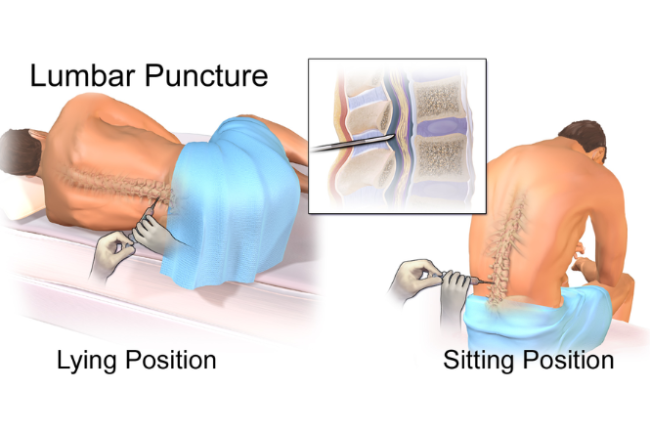Lumbar puncture test
Key points about lumbar puncture
- A lumbar puncture is a test where a needle is inserted into the lower part of your spine to remove some spinal fluid.
- It's done to look for (or exclude) conditions affecting your spine, brain or nervous system.
- It may also be used to deliver medicines directly into the cerebrospinal fluid in your spine, eg, antibiotics or chemotherapy.

A lumbar puncture is most commonly performed in hospital, either during an appointment or an inpatient stay. You don't need to do anything specific to prepare for it. The doctor will discuss the reason they want to do the test and any risks involved and will give you time to ask questions before signing a consent form.
You will lie on your side, legs pulled up with your chin tucked in, or you may be seated and leaning forward. This helps open up the space between the vertebrae (bones in your spine).
Image credit: BruceBlausen Wikimedia Commons
When you and the doctor are ready to begin, they will give you a small local anaesthetic injection into your skin before a needle is inserted between 2 vertebrae into your spinal canal.
Once the needle is in the right place, a few drops of cerebrospinal fluid are collected into a sterile container and sent to the lab. If needed, the spinal pressure can also be measured.
- The needle is only in your back for a few minutes although the whole procedure takes 20–45 minutes.
- You will have a small plaster over the exit point.
- Once finished, you will be asked to stay in bed, or sitting down for a short while, before getting up to walk.
- It is safe to walk around after the procedure as walking hasn't been shown to increase the risk of developing a headache or backache. However, it is still best to take it easy for the rest of the day.
Any test or procedure carries risks, and your doctor will discuss these with you before the procedure. For a lumbar puncture, the risk of any major complication is very small. About 1 in 5 people report a headache or backache within the next 24–48 hours. This can be treated by drinking plenty of fluids and taking a painkiller such as paracetamol.
Some results are available within an hour while others may take up to 48 hours. Your healthcare provider will explain your results to you when they are available.
Lumbar puncture factsheet(external link) KidsHealth, NZ
Lumbar puncture(external link) NHS, UK
Credits: Healthify editorial team. Healthify is brought to you by Health Navigator Charitable Trust.
Reviewed by: Dr Bryony Harrison
Last reviewed:
Page last updated:





